Media
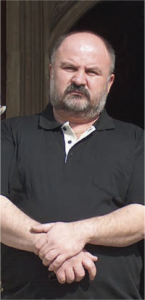
EDUARD POPESCU
The lively owner of Bucharest-based but Romania-wide Medieval Tours is adept at bringing the country’s history to life and can tailor-make itineraries to suit particular interests. The straight-speaking, charming host, who honed his skills as a freelance guide for over a decade, brings personality and humour to Romania’s often dark history, and provides a chance to explore the rural Romania seldom encountered by tourists.
88 Matei Basarab Street, Bloc L116, Sc. A, Etaj 5. Ap. 13, Sector 3, Bucharest, Romania
+40 21 326 6268, www.medievaltours.com

“Also putting together tours, this time for a clientele seeking sophisticated lodgings and looking for a touch of class and potentially specialized interests — like Jewish heritage, for example — is Eduard Popescu of Medieval Tours, Bd. Magheru 32-36, sc. C. ap. 17, 010337 Bucharest (tel. 021/326-6268 or 0721-162-323; www.medievaltours.com ). Eduard will not only tailor-make a tour that will bring Romania to life in an especially memorable way, but he’ll also go above and beyond the call of duty to attend to special requests and unique interests. Fond of seeking out the undiscovered and not afraid to say it how it is, Eduard injects his tours with great charm and humor — if you want to discover the grown-up version of Romanian history and get under the country’s skin whilst seeing its most alluring sights, this is an especially satisfying option.”

Jewish Romania and The Great Synagogue, Bucharest
Romania is rich in Jewish heritage. Would you believe the first Jews arrived as part of Roman legions (Legion Judaica) that invaded Dacia in 101 AD? During the Middle Ages, Jewish immigrants initially settled in Walachia and Moldova while more arrived after Spain expelled the Jews in 1492. By the early Sixteenth Century, numbers increased as immigrants fled Cossack uprisings in Poland and Ukraine.
Polish Jewish merchants set up storehouses, trading posts, and permanent settlements during the Fifteenth and Sixteenth Centuries and under Turkish rule, the Romanian Jewish Community evolved into a prosperous middle class. Romania has almost 100 well-maintained synagogues of which half are still used for worship, and more than 800 cemeteries scattered through the country.
The Romania Tourist Bureau (who has an excellent website) graciously allowed access to information and put us in touch with Eduard Popescu, Medievaltours. Eduard leads customized tours through Jewish Romania, Saxon Heritage, Bucharest and will even assist in searching family roots.
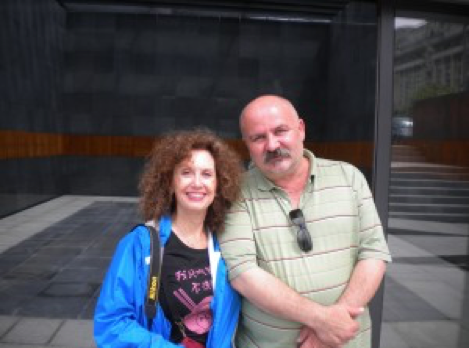
Travels With Sheila and Eduard, Medieval Tours in Bucharest
Bucharest, is home to one of the oldest and most important Jewish communities in Romania. Sephardic Jews first arrived here in the Sixteenth Century followed by Ashkenazi Jews later. A sacred brotherhood, charity box and prayer house were registered in 1715. Some of the synagogues built during the Eighteenth and Nineteenth Centuries also featured ritual baths (mikve) and 10 holy houses were established by 1832; almost each had its own Rabbi. By the beginning of the Twentieth Century, Bucharest’s Jewish population had grown to 40,000 with 70 temples and synagogues. Only a few survived World War II and communism, and two still serve the city’s small Jewish community.
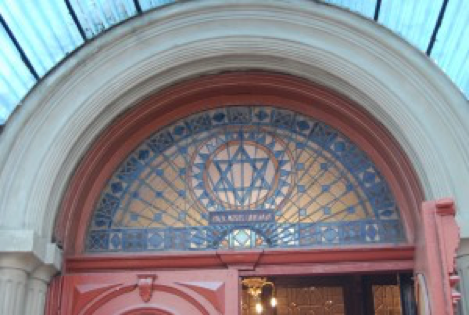
Entrance to The Great Synagogue, Bucharest
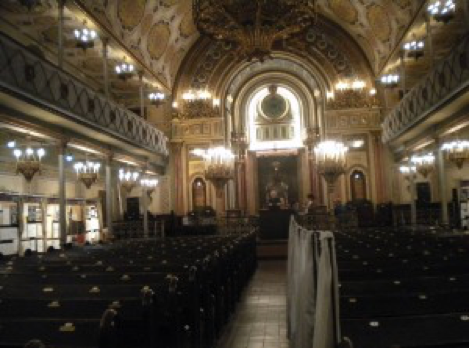
Inside The Great Synagogue, Bucharest
It was raining and the weather forecast predicted rain for days to come. Dressed in waterproofs, Eduard picked us up at 10a promptly and we set off to tour Jewish Bucharest beginning with the Great Synagogue.
Properly called the Dr. Moses Rosen Museum of the History of the Jewish Community in Romania – Holocaust Museum, and housed in the magnificently preserved Great Synagogue (1850), this museum traces the history of Romania’s Jewish population.
Inside is a collection of books written, published, illustrated or translated by Romanian Jews; a small collection of paintings of and by Romanian Jews (many of the same artists’ works hang in the National Museum of Art); and memorabilia from Jewish theaters, including the State Jewish Theater. The museum also contained a large collection of Jewish ritual objects from Romania, collected by Rabbi Moses Rosen (1912–1994), the late Chief Rabbi of Romanian Jewry.
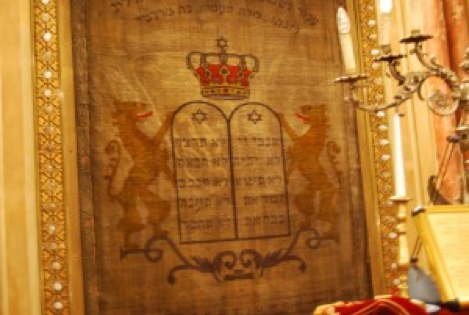
Ten Commandments covering the aron ha-kodesh (the holy ark), Great Synagogue, Bucharest
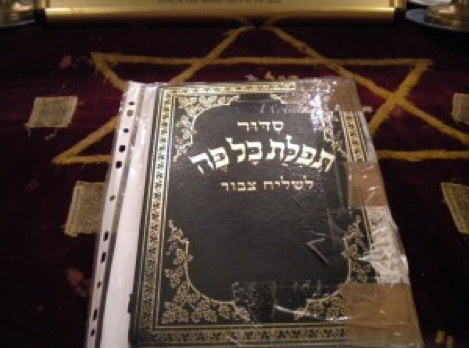
Bible in The Great Synagogue, Bucharest, Romania
Only a few Israelis were inside along with an older man in his 80s called the “architect” who insisted on taking us around and relating information; when it was built and how many people still live in Bucharest. We were also told that the majority of Jews exterminated before World War II were killed by Romanian extremists. This massacre took place in North Romania around Moldova.
One of the most heart-wrenching exhibits showed photographs of the very few Righteous Among The Nations as recognized by Yad Vashem who risked their lives to save Jews. Many Christians provided false papers and identities, smuggled and helped Jews escape, and rescued children. Sixty brave Romanians have been recognized by Yad Vashem as the Righteous Among The Nations. God bless them…
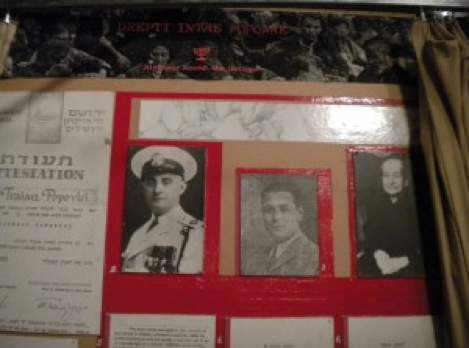
Three photographs of Romania’s “Righteous Among The Nations” in The Great Synagogue, Bucharest
Services were currently being held in the Great Synagogue because the Choral Temple was being restored. (Temple and Synagogue both refer to a Jewish place of worship and are used interchangeably.) When restoration is completed, services will be held in the Choral Temple built in 1867. This red brick temple is noted for magnificent Moorish turrets and is the largest active synagogue in Bucharest.
Next, the Jewish State Theatre…

